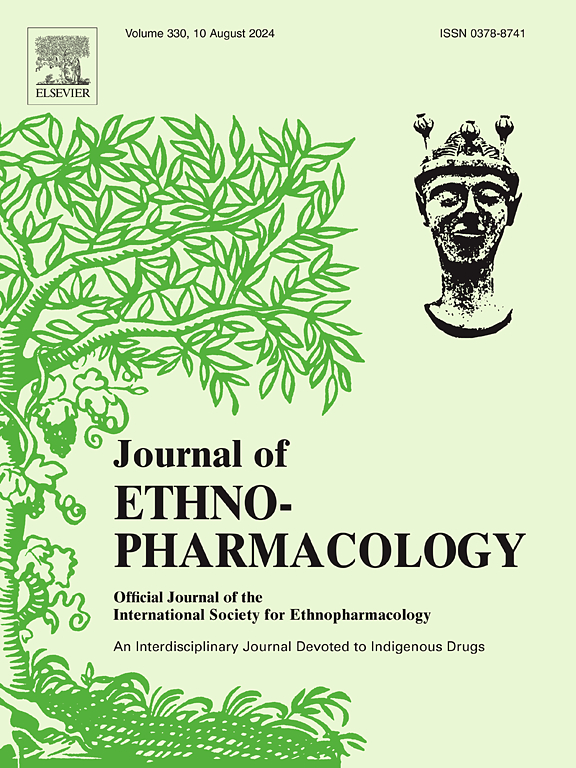Chinese medicine preparation Pudilan anti-inflammatory oral liquid: Chemical constituents and developmental toxicity
IF 5.4
2区 医学
Q1 CHEMISTRY, MEDICINAL
引用次数: 0
Abstract
Ethnopharmacological relevance
Pudilan anti-inflammatory oral liquid (PDL) is a classical Chinese herbal formulation. Traditionally used to treat respiratory infections, sore throat, and mumps, it is widely administered in children and pregnant women due to its perceived safety. However, recent guidelines advise caution in these populations, raising concern about its developmental toxicity. This study investigates the chemical profile and embryotoxic effects of PDL to bridge traditional use with modern toxicological evaluation.
Aims of the study
To identify the chemical constituents of PDL and evaluate its developmental toxicity, as well as elucidate potential toxicological mechanisms using a zebrafish embryo model.
Materials and methods
The chemical composition of PDL was characterized using ultra-high performance liquid chromatography coupled with quadrupole time-of-flight mass spectrometry (UHPLC-QTOF-MS). Zebrafish (Danio rerio) embryos were exposed to various PDL concentrations. Developmental toxicity was assessed through mortality, malformation, hatching, heart rate, body length, spontaneous movement, and locomotor activity. Histological analysis, transcriptomic profiling, and qRT-PCR validation were conducted to explore underlying mechanisms.
Results
Baicalin was identified as the dominant flavonoid, followed by baicalein and wogonin. PDL exposure induced dose-dependent developmental toxicity, including increased mortality, malformations, and impaired cardiac and behavioral functions. Transcriptomic analysis revealed dysregulation in cell cycle, DNA replication, and steroid biosynthesis pathways.
Conclusion
PDL exhibits significant embryotoxicity in zebrafish, potentially mediated by flavonoid-induced disruption of developmental pathways. These findings highlight the need for safety assessments of traditional formulations, particularly in vulnerable populations.

中药制剂蒲地兰抗炎口服液:化学成分及发育毒性。
民族药理学相关性:蒲地兰抗炎口服液(PDL)是一种经典的中草药制剂。传统上用于治疗呼吸道感染、喉咙痛和腮腺炎,由于其安全性被广泛用于儿童和孕妇。然而,最近的指南建议在这些人群中谨慎使用,这引起了人们对其发育毒性的担忧。本研究探讨了PDL的化学特征和胚胎毒性作用,以架起传统应用与现代毒理学评价之间的桥梁。研究目的:利用斑马鱼胚胎模型,鉴定PDL的化学成分,评价其发育毒性,并阐明其潜在的毒理学机制。材料与方法:采用超高效液相色谱-四极杆飞行时间质谱(UHPLC-QTOF-MS)对PDL的化学成分进行表征。斑马鱼胚胎暴露于不同浓度的PDL。通过死亡率、畸形、孵化、心率、体长、自发运动和运动活动来评估发育毒性。通过组织学分析、转录组学分析和qRT-PCR验证来探索潜在的机制。结果:黄芩苷为主要黄酮类化合物,黄芩苷次之,黄芩苷次之。PDL暴露引起剂量依赖性发育毒性,包括死亡率增加、畸形、心脏和行为功能受损。转录组学分析揭示了细胞周期、DNA复制和类固醇生物合成途径的失调。结论:PDL对斑马鱼具有明显的胚胎毒性,可能是由黄酮类化合物诱导的发育通路中断介导的。这些发现突出了对传统配方进行安全性评估的必要性,特别是在脆弱人群中。
本文章由计算机程序翻译,如有差异,请以英文原文为准。
求助全文
约1分钟内获得全文
求助全文
来源期刊

Journal of ethnopharmacology
医学-全科医学与补充医学
CiteScore
10.30
自引率
5.60%
发文量
967
审稿时长
77 days
期刊介绍:
The Journal of Ethnopharmacology is dedicated to the exchange of information and understandings about people''s use of plants, fungi, animals, microorganisms and minerals and their biological and pharmacological effects based on the principles established through international conventions. Early people confronted with illness and disease, discovered a wealth of useful therapeutic agents in the plant and animal kingdoms. The empirical knowledge of these medicinal substances and their toxic potential was passed on by oral tradition and sometimes recorded in herbals and other texts on materia medica. Many valuable drugs of today (e.g., atropine, ephedrine, tubocurarine, digoxin, reserpine) came into use through the study of indigenous remedies. Chemists continue to use plant-derived drugs (e.g., morphine, taxol, physostigmine, quinidine, emetine) as prototypes in their attempts to develop more effective and less toxic medicinals.
 求助内容:
求助内容: 应助结果提醒方式:
应助结果提醒方式:


